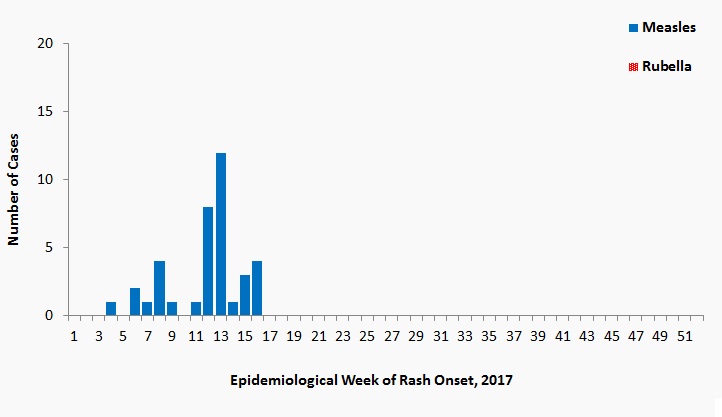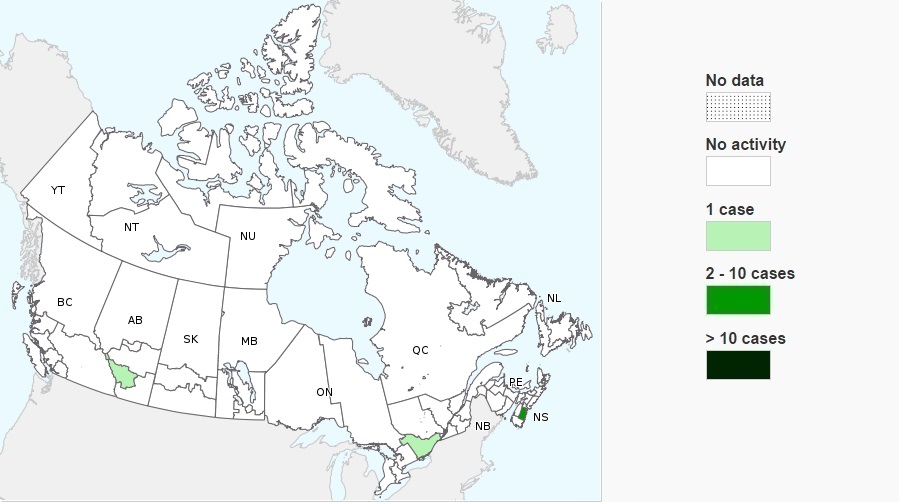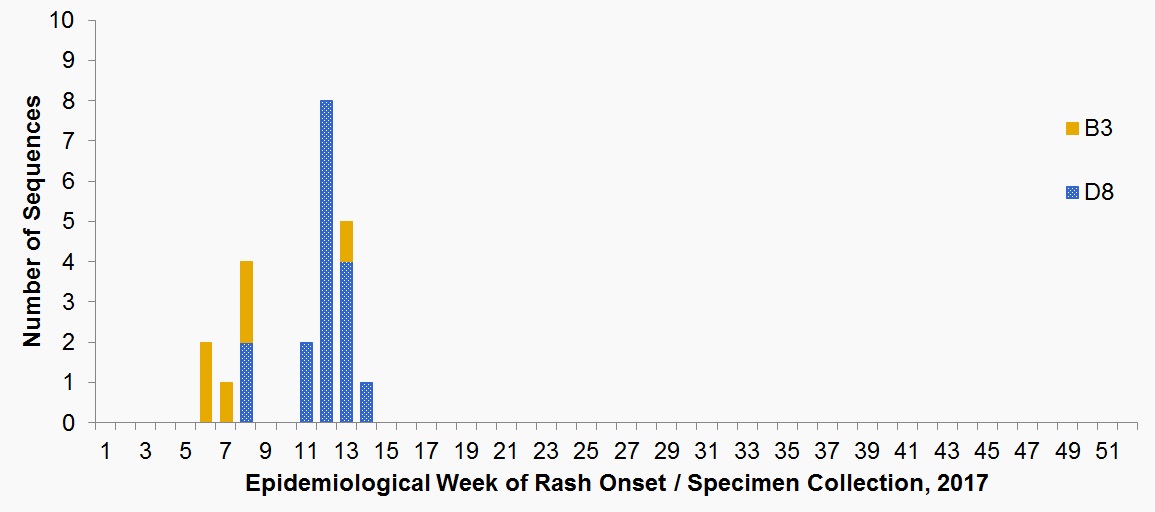Measles & Rubella Weekly Monitoring Report - Week 16, 2017: April 16 to April 22, 2017
Key Points
- In Canada, 7 new cases of measles were reported in week 16, 2017.
- Three provinces have active measles cases: Nova Scotia (n=8), Ontario (n=1), and Alberta (n=1).
- A total of 38 cases of measles, and zero cases of rubella have been reported in Canada in 2017.
Organization: Public Health Agency of Canada
Date published: 2017-05-03
On this page
Epidemiological Summary
During epidemiological week 16, 2017, 7 new cases of measles were reported in Canada from two different provinces Nova Scotia (n=6) and Ontario (n=1)Footnote 1. These cases had rash onsets during week 15 (n=3) and week 16 (n=4).
To date in 2017, 38 cases of measles have been reported in Canada, resulting from 8 unique importation events. Of these importation events, three have led to secondary transmission. An outbreak in February has since been declared over, while an importation in March has resulted in 23 secondary cases reported across four different provinces. One case from Ontario has an epidemiological link with a previously reported case which had a travel history to Pakistan.
No cases of rubella have been reported in 2017 (Figure 1). It has been 61 epidemiologic weeks since the last rubella case was reported (week 6, 2016).
Figure 1: Number of cases of measles (n=38) and rubella (n=0), by week of rash onset, as reported to the Canadian Measles/Rubella Surveillance System (CMRSS) and Measles and Rubella Surveillance system (MARS), for the period ending April 22, 2017.

Figure 1 – Text Description
| Epidemiological Week of Rash Onset, 2017 | Number of confirmed measles cases reported | Number of confirmed rubella cases reported |
|---|---|---|
| 1 | 0 | 0 |
| 2 | 0 | 0 |
| 3 | 0 | 0 |
| 4 | 1 | 0 |
| 5 | 0 | 0 |
| 6 | 2 | 0 |
| 7 | 1 | 0 |
| 8 | 4 | 0 |
| 9 | 1 | 0 |
| 10 | 0 | 0 |
| 11 | 1 | 0 |
| 12 | 8 | 0 |
| 13 | 12 | 0 |
| 14 | 1 | 0 |
| 15 | 3 | 0 |
| 16 | 4 | 0 |
| Missing Rash Onset | 0 | 0 |
| Cases (year-to-date) | 38 | 0 |
Geographic Distribution
There are currently 10 reported activeFigure 2 – Footnote * cases of measles in Canada, 8 in Nova Scotia, 1 in Ontario, and 1 in Alberta (Figure 2).
There are no reported active cases of rubella in Canada (Figure not shown).
Maps from previous weeks, including any retrospective updates, are available online in the Measles and rubella weekly surveillance maps feature.
Figure 2: Distribution of activeFigure 2 – Footnote *, confirmed measles cases by health region

- Figure 2 – Footnote *
-
Active cases or outbreaks are those in which the onset date of the most recent case/outbreak-associated case falls within 32 days of the issue date of this reportFootnote 2.
Figure 2 – Text Description
| Health Region | Measles Cases | Rubella Cases |
|---|---|---|
| Eastern Regional Integrated Health Authority | 0 | 0 |
| Central Regional Integrated Health Authority | 0 | 0 |
| Western Regional Integrated Health Authority | 0 | 0 |
| Labrador-Grenfell Regional Integrated Health Authority | 0 | 0 |
| Prince Edward Island | 0 | 0 |
| South Shore District Health Authority | 8 | 0 |
| South West Nova District Health Authority | 0 | 0 |
| Annapolis Valley District Health Authority | 0 | 0 |
| Colchester East Hants Health Authority | 0 | 0 |
| Cumberland Health Authority | 0 | 0 |
| Pictou County Health Authority | 0 | 0 |
| Guysborough Antigonish Strait Health Authority | 0 | 0 |
| Cape Breton District Health Authority | 0 | 0 |
| Capital District Health Authority | 0 | 0 |
| Zone 1 (NB) | 0 | 0 |
| Zone 2 (NB) | 0 | 0 |
| Zone 3 (NB) | 0 | 0 |
| Zone 4 (NB) | 0 | 0 |
| Zone 5 (NB) | 0 | 0 |
| Zone 6 (NB) | 0 | 0 |
| Zone 7 (NB) | 0 | 0 |
| Québec et Chaudières-Appalaches | 0 | 0 |
| Centre-du-Québec | 0 | 0 |
| Montréal et Laval | 0 | 0 |
| Ouest-du-Québec | 0 | 0 |
| Montérégie | 0 | 0 |
| Nord-Est | 0 | 0 |
| Ontario Central East | 0 | 0 |
| Ontario Central West | 0 | 0 |
| Ontario Eastern | 1 | 0 |
| Ontario North East | 0 | 0 |
| Ontario North West | 0 | 0 |
| Ontario South West | 0 | 0 |
| City of Toronto Health Unit | 0 | 0 |
| Winnipeg Regional Health Authority | 0 | 0 |
| Prairie Mountain Health | 0 | 0 |
| Interlake-Eastern Regional Health Authority | 0 | 0 |
| Northern Regional Health Authority | 0 | 0 |
| Southern Health | 0 | 0 |
| Saskatchewan South | 0 | 0 |
| Saskatchewan Central | 0 | 0 |
| Saskatchewan North | 0 | 0 |
| South Zone | 0 | 0 |
| Calgary Zone | 1 | 0 |
| Central Zone | 0 | 0 |
| Edmonton Zone | 0 | 0 |
| North Zone | 0 | 0 |
| British Columbia | 0 | 0 |
| Yukon | 0 | 0 |
| Northwest Territories | 0 | 0 |
| Nunavut | 0 | 0 |
|
||
Laboratory Summary
Measles
To date in 2017, 23 measles cases have been genotyped and the genotypes are B3 (n=6) and D8 (n=17) (Figure 3). Genotype information is pending for 5 additional cases. Each unique importation has been associated to a genotype. During the first outbreak in Nova Scotia, 5 cases (71%) were genotyped, and the genotype was B3. To date, 12 cases (50%) from the multi-jurisdictional outbreak beginning in March 2017 have been genotyped; 10 from Nova Scotia, 1 from Ontario and 1 from Alberta. All were genotype D8.
During epidemiological week 16, 2017, 4 new measles genotype result became available. All four cases had an identical genotype D8 sequence to an imported case from India (Week 11), and were epidemiologically linked to that case. A total of 12 cases (index case imported from India and 11 secondary cases with documented exposure to the index case) with identical sequences have been identified across three provinces.
Figure 3: Distribution of measles genotypes detected in 2017 (n=23) by weekFigure 3 – Footnote † of rash onset.

- Figure 3 – Footnote †
-
Epidemiological weeks for laboratory specimens are assigned in accordance with WHO guidelines (WHO.WER.2012;9 (87):73) with week 1 beginning on the first Monday of the year.
Figure 3 – Text Description
| Epi week | B3 | B3 – Harare | D4 | D8 | D8 – Taunton | D9 | H1 | Total |
|---|---|---|---|---|---|---|---|---|
| 1 | 0 | 0 | 0 | 0 | 0 | 0 | 0 | 0 |
| 2 | 0 | 0 | 0 | 0 | 0 | 0 | 0 | 0 |
| 3 | 0 | 0 | 0 | 0 | 0 | 0 | 0 | 0 |
| 4 | 0 | 0 | 0 | 0 | 0 | 0 | 0 | 0 |
| 5 | 0 | 0 | 0 | 0 | 0 | 0 | 0 | 0 |
| 6 | 2 | 0 | 0 | 0 | 0 | 0 | 0 | 2 |
| 7 | 1 | 0 | 0 | 0 | 0 | 0 | 0 | 1 |
| 8 | 2 | 0 | 0 | 2 | 0 | 0 | 0 | 4 |
| 9 | 0 | 0 | 0 | 0 | 0 | 0 | 0 | 0 |
| 10 | 0 | 0 | 0 | 0 | 0 | 0 | 0 | 0 |
| 11 | 0 | 0 | 0 | 2 | 0 | 0 | 0 | 2 |
| 12 | 0 | 0 | 0 | 8 | 0 | 0 | 0 | 8 |
| 13 | 1 | 0 | 0 | 4 | 0 | 0 | 0 | 5 |
| 14 | 0 | 0 | 0 | 1 | 0 | 0 | 0 | 1 |
| 15 | 0 | 0 | 0 | 0 | 0 | 0 | 0 | 0 |
| 16 | 0 | 0 | 0 | 0 | 0 | 0 | 0 | 0 |
| Total | 6 | 0 | 0 | 17 | 0 | 0 | 0 | 23 |
|
||||||||
The current global distribution of measles genotypes can be found on the WHO Measles Surveillance website.
For information regarding the interpretation and use of measles genotyping (including a discussion of genotypes and sequence variants), refer to Hiebert J and Severini A. Canada Communicable Disease Report. 2014; 40-12: 257- 260.
Rubella
To date in 2017, no rubella cases have been genotyped.
Footnotes
- Footnote 1
-
Only cases with rash onset up to the indicated end date are included in this report. Any additional cases will be described in future reports.
- Footnote 2
-
Public Health Agency of Canada. Guidelines for the prevention and control of measles outbreaks in Canada. Canadian Communicable Disease Report. 2013. Vol. 39: Definitions: conclusion of an outbreak (p. 5).